The recent rise of tools like ChatGPT has made the idea of a robot assistant more tangible than it was even a year ago. But AI isn’t a thing of the future. With exciting new tools like conversational AI, it’s already here, and it’s changing the way we work for the better.
At surface level, conversational AI operates through virtual agents that can alleviate customer care team load and streamline the user experience. But that’s just the beginning. Besides improving workflows and the customer experience, conversational AI is a powerful tool for business intelligence, sentiment analysis and so much more.
In this article, you’ll learn the ins and outs of conversational AI, and why it should be the next tool you add to your team’s digital toolbox for social media and beyond.
Table of contents—feel free to skip ahead:
- What is conversational AI?
- What is the business impact of conversational AI?
- How does conversational AI work?
- 4 practical examples of conversational AI
- Common challenges with AI conversation tools
What is conversational AI?
Conversational AI is the technology that enables specific text- or speech-based AI tools—like chatbots or virtual agents—to understand, produce and learn from human language to create human-like interactions.
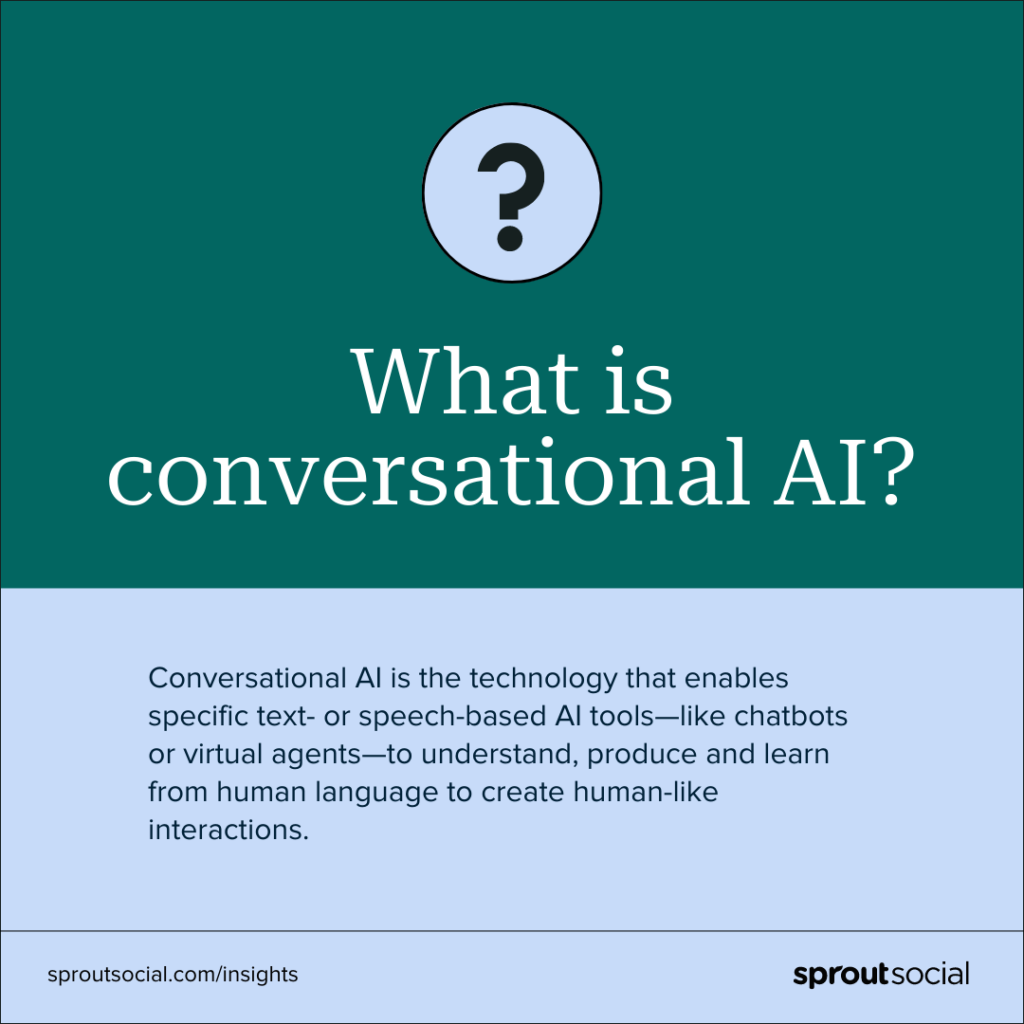
Customer service chatbots are one of the most common examples of where conversational AI can be used in marketing. But not every chatbot uses this technology. Here’s the difference:
- Rule-based chatbots, like those offered in Sprout Social’s Bot Builder, have question-and-answer pathways already set up. Rule-based chatbots are extremely useful when it comes to offloading general inquiries and FAQs from customer service teams’ plates. These chatbots can also provide business insights by uncovering common pain points, themes and service issues in customer inquiries.
- Conversational AI agents and assistants go further. They use neural networks, natural language processing (NLP) and named entity recognition (NER) to contextually understand customer queries and provide the appropriate responses. They keep adding new words and phrases from customer interactions to their vocabulary, becoming smarter and more precise with time.
What is the business impact of conversational AI?
Conversational AI tools and the customer learnings you glean from them have the power to improve and impact your entire business—from providing a better customer experience to giving your org a competitive edge and improving workflows.
More teams are starting to recognize the importance of AI marketing tools as a “must-have”—not a “nice-to-have.” Conversational AI is no exception. In fact, nearly 9 in 10 business leaders anticipate increased investment in AI and machine learning (ML) for marketing over the next three years.
Here are a few reasons why conversational AI is one of the tools you should consider integrating into your tech stack.

A better customer experience
A stellar customer experience can make or break your business. Consumers expect smooth, helpful service on social media, and fast—most US consumers expect a response on social within 24 hours, according to The 2022 Sprout Social Index™.
Conversational AI speeds up the customer care process within business hours and beyond, so your support efforts continue 24/7. Virtual agents on social or on a company’s website can juggle multiple customers and queries at once, quickly. And with access to a customer’s order and interaction history, customers receive a seamless experience across channels.
Conversational AI also creates a personalized customer experience. A virtual retail agent can make tailored recommendations for a customer, moving them down the funnel faster—and shoppers are looking for this kind of help. According to PwC, 44% of consumers say they would be interested in using chatbots to search for product information before they make a purchase.
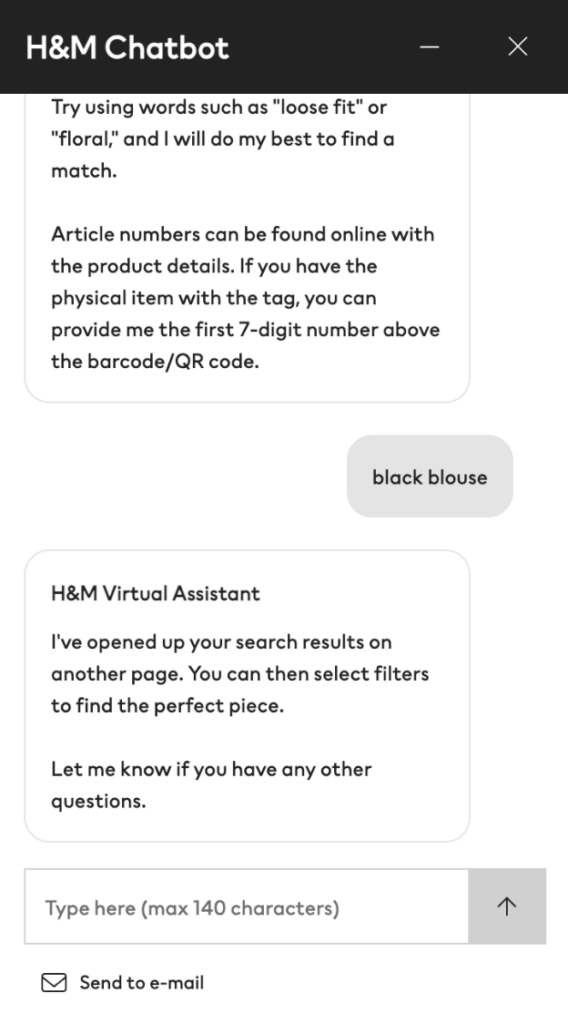
More efficient workflows
Conversational AI is not a replacement for teams. Rather, it’s a tool meant to make your teams more productive. In fact, in a Q2 2023 Sprout pulse survey of 255 social marketers, 82% of marketers who have integrated AI and ML into their workflow have already achieved positive results.
AI can handle FAQs and easy-to-resolve tasks, which frees up time for every team member to focus on higher-level, complex issues—without leaving users waiting on hold.
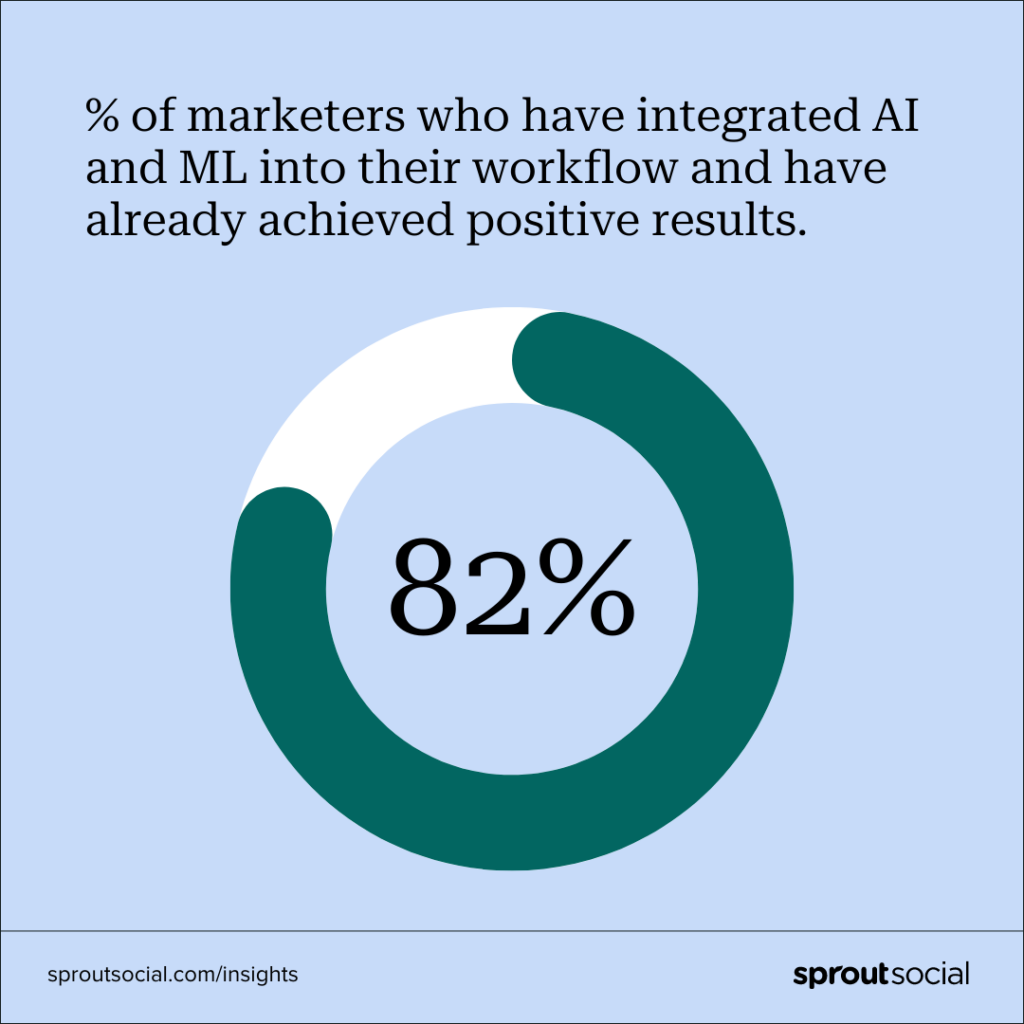
Conversational AI helps alleviate workload, especially when paired with other AI-powered tools. For example, while conversational AI handles FAQs, tapping AI copy generation tools, like Sprout Social’s AI Assist, also accelerates the responses your social or customer care team writes.
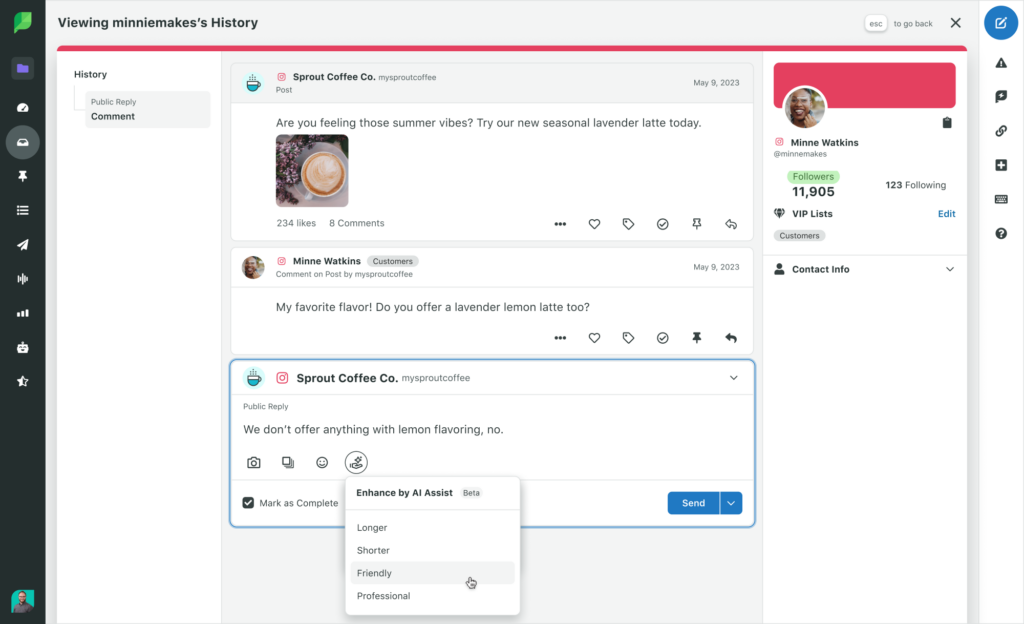
Improved accessibility
Conversational AI opens doors for a more accessible customer experience.
For example, it helps break down language barriers—especially important for large companies with a global audience. While your customer care team may be limited to helping customers in just a few languages, virtual assistants can offer multiple language options.
And conversational voice AI tools create an even more seamless and accessible experience for customers, empowering them to get answers without ever needing to type on a keyboard.
The ability to make better business decisions
AI technology is already empowering companies to make smarter business decisions. According to The 2023 State of Media Report, 96% of business leaders agree that AI and ML can help companies significantly improve decision-making processes.
Conversational AI tools are no exception. Every conversation a virtual agent has generates data about its users, which can help you analyze sentiment, uncover customer insights and make improvements to your product or digital experience. Some tools can take this even further by performing data analyses, and even providing recommendations for you.
Gaining a competitive advantage
Everything we’ve mentioned so far ladders up to one truth: A company using tools like conversational AI has the potential to outpace competitors who have yet to adopt the same technology.
In fact, The 2023 State of Social Media Report found that 59% of business leaders agree that investing in emerging technologies to create efficient workflows could give companies a competitive advantage going forward. This edge comes in the form of giving your teams more time to be innovative, speeding up workflows and positioning your brand as truly customer-centric.
As these AI-driven tools become more mainstream, adopting them will become more important when it comes to pulling ahead—and staying there.
How does conversational AI work?
Conversational AI uses technology like natural language processing (NLP) to interpret human text or speech. Processes like named entity recognition (NER) help these tools identify important words within text or phrases they read or hear. And it then uses natural language generation (NLG) to create responses that mimic very human conversations.
Unlike rule-based bots, conversational AI tools, like those you might interact with on social media or a website, learn and improve their interpretation and responses over time thanks to neural networks and ML. The more conversations occur, the more your chatbot or virtual assistant learns and the better future interactions will be.
4 practical examples of conversational AI
We’ve already teased a few ways conversational AI can fit into your workflow. But there are many ways it can fit into your business across multiple teams.
Let’s explore four practical ways conversational AI tools are being used across industries.
1. FAQs and personalized customer service
Customer service chatbots are one of the most prominent use cases of conversational AI. So much so that 93% of business leaders agree that increased investment in AI and ML will be crucial for scaling customer care functions over the next three years, according to The 2023 State of Social Media Report.
An AI-powered customer experience means that customers can be helped 24/7. And these bots’ ability to mimic human language means your customers still receive a friendly, helpful and fast interaction.
But this doesn’t replace the need for your human team. Rather, the efficiency of AI customer service tools triage the “easy” questions so that your team has more time to dedicate to more complex customer issues.
2. Stronger data collection and consumer insights
Every conversation a customer service chatbot has with customers is data. Conversational AI enables you to use this data to uncover rich brand insights and get an in-depth understanding of your customers to make better business decisions, faster.
An AI-based tool synthesizes data gathered from customer conversations—think, your virtual agents and AI-based chatbots—using tasks like sentiment analysis and named entity recognition (NER) to give you granular, actionable insights about your brand and customer. These insights help you build more targeted marketing campaigns, improve products and services and remain agile in a competitive market.
3. Selling directly to customers
Conversational AI can go beyond helping resolve customer issues by selling, or upselling. Walmart’s “text to shop” tool is a stand-out example of this in action. Customers can search and shop for specific products, or general keywords, to receive personalized recommendations. And with inventory and product shipment tracking, shoppers have visibility into what’s in stock and where their orders are.

You already know that virtual assistants like this can facilitate sales outside of working hours. But this method of selling can also appeal to younger generations, and the way they like to shop. In a recent report, 71% of of Gen Z respondents want to use chatbots to search for products.
4. Empowering customer self-service
Conversational AI shines when it comes to empowering customers to handle a simple issue themselves.
This is why it has proven to be a helpful tool in the banking and financial industry. One article even declared 2023 as “the year of the chatbot in banking.” Through an AI conversation, customers can handle simple self-service issues, like checking balances. But it can also help with more complex issues, like providing suggestions for ways a user can spend their money.
This has also proven helpful in the healthcare industry, where no one wants to be left waiting. Conversational AI alleviates long wait times and patient friction by handling the quicker tasks—freeing up your team to address more complex patient needs.
Using conversational AI, patients can schedule appointments at nearby locations, request prescription refills, access educational resources and can even receive diagnoses for minor issues, helping to alleviate waiting room congestion. And in both of these industries, AI can serve as a starting point for users before routing them to the appropriate department or person to talk to.
Common challenges with AI conversation tools
Implementing conversational AI into your team workflows opens many doors. But this new technology is not without its bumps. Let’s explore some common challenges that come up for these tools and the teams using them.
Insufficient training
With any new technology, there’s a learning curve or some uncertainty. Conversational AI tools are no different.
According to The 2023 State of Social Media report, three of the top challenges a company may face in utilizing AI and ML technology in marketing include insufficient training and development for business leaders, limited org experience and a lack of understanding among business leaders about how AI and ML work.
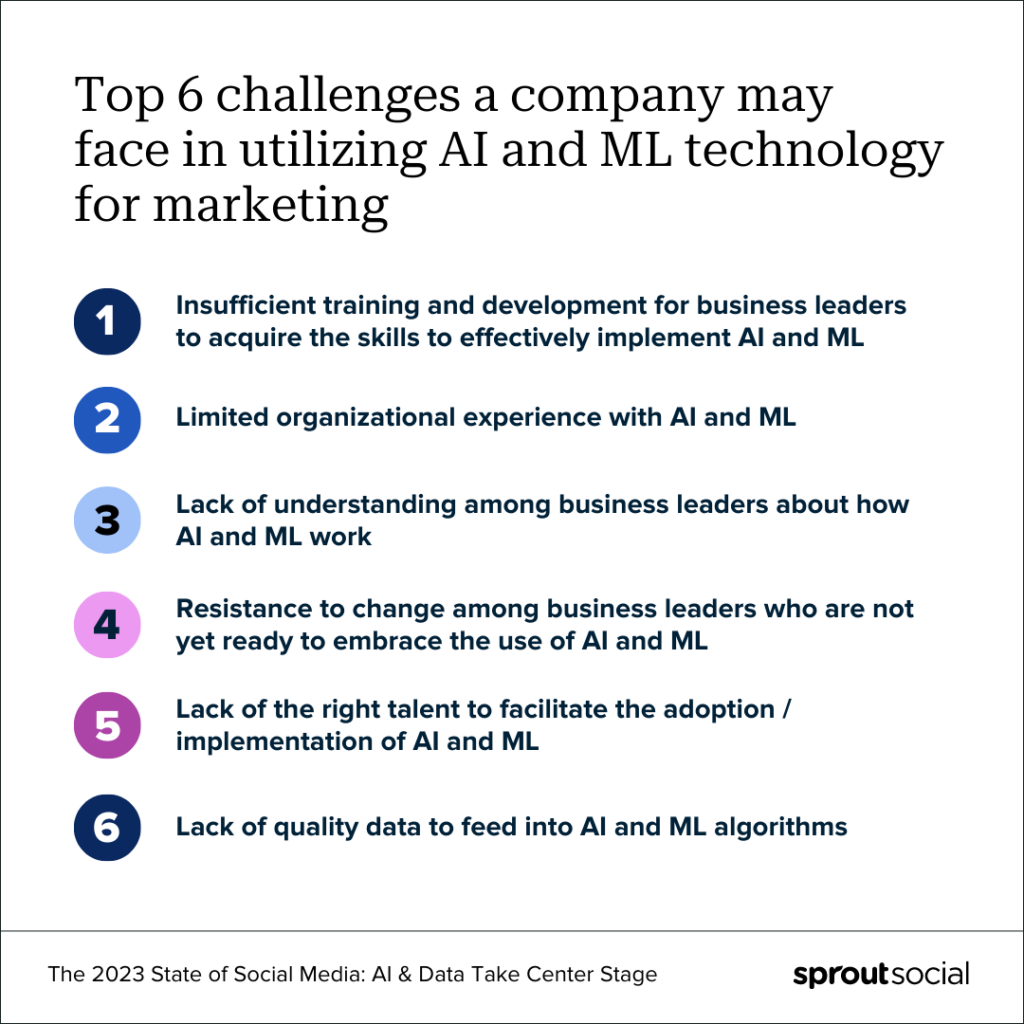
Despite this challenge, there’s a clear hunger for implementing these tools—and recognition of their impact. In that same report found, 86% of business leaders agree implementation of AI and ML tech is critical for long-term business success.
Conversational AI as we know it today certainly requires a learning curve. Even as these tools become more seamless to implement, businesses (and leadership teams) can benefit from working with trusted AI vendors who can support your team’s ongoing education.
Data privacy
What do two of the industries we’ve mentioned—banking and healthcare—have in common? They both handle highly sensitive personal information that must remain secure.
In any industry where users input confidential details into an AI conversation, their data could be susceptible to breaches that would expose their information, and impact trust.
This means you’ll need to vet conversation AI apps with data privacy and security in mind. What are the tool’s safeguards? Are they meeting industry compliance standards and requirements?
Ever-evolving human language
Ironically, it’s the human element that leads to one of the challenges with conversational AI. Human language is constantly evolving. And while AI conversation tools are meant to always learn, the changing nature of language can create misunderstandings.
For text-based virtual assistants, jargon, typos, slang, sarcasm, regional dialects and emoticons can all impact a conversational AI tool’s ability to understand.
For speech-based tools, background noise, accents and connectivity issues can all lead to a user’s need to repeat information multiple times—which doesn’t result in a satisfying user experience.
User apprehension
We have all dialed “0” to reach a human agent, or typed “I’d like to talk to a person” when interacting with a bot. Not everyone is ready or wants to always have an AI conversation.
But a desire for a human conversation doesn’t need to squash the idea of adopting conversational AI tech. Rather, this is a sign to make conversations with a “robot assistant” more humanlike and seamless—a direction these tools are moving in. According to PwC, speed, convenience, helpful employees and friendly service matter most to consumers—all elements a well-trained AI virtual assistant can provide, while freeing your team to provide those qualities themselves.
Plus, this may prove to be a preference for the next generation of shoppers. In a Tidio study, 60% of Gen Z respondents found chatting with customer service representatives to be stressful.
It’s time to have a chat with your team about conversational AI
We’ve entered the era where “ask a robot” is becoming more of a norm. As conversational AI technology becomes more mainstream—and more advanced—bringing it into your team’s workflow will become a crucial way to keep your organization ahead of the competition.
The day where an AI assistant is the norm isn’t sci-fi or speculation—it’s already here. To keep exploring the potential impact AI tools can have on your teams’ workflows, check out our data on the future of AI in marketing.
What is the difference between chatbot and conversational AI?
Chatbots are often rule-based, and follow preset question-and-answer pathways. They still answer FAQs effectively, but are limited to their predetermined question prompts and answers. Conversational AI agents and virtual assistants have the ability to understand human language, learn from new words and interactions and produce human-like speech.
What is an example of conversational AI?
One of the most recognizable examples of conversational AI is something you may have in your home, or on your phone right now: Amazon’s Alexa or the Google Home, or iPhone’s Siri assistant.


